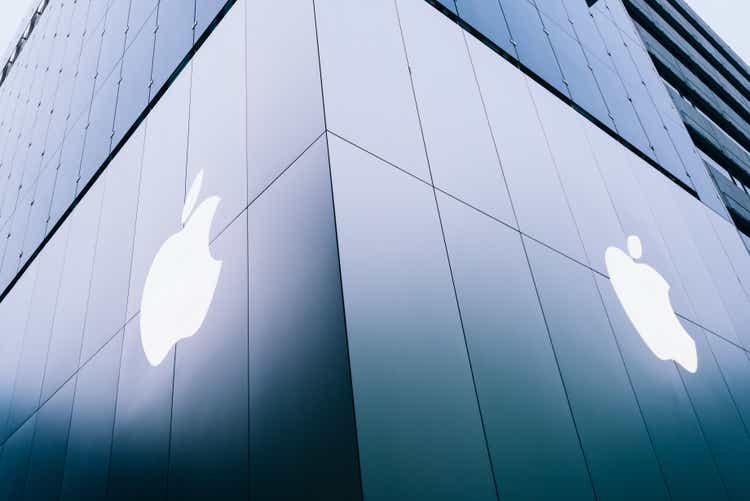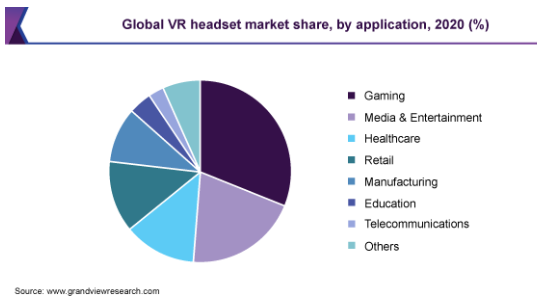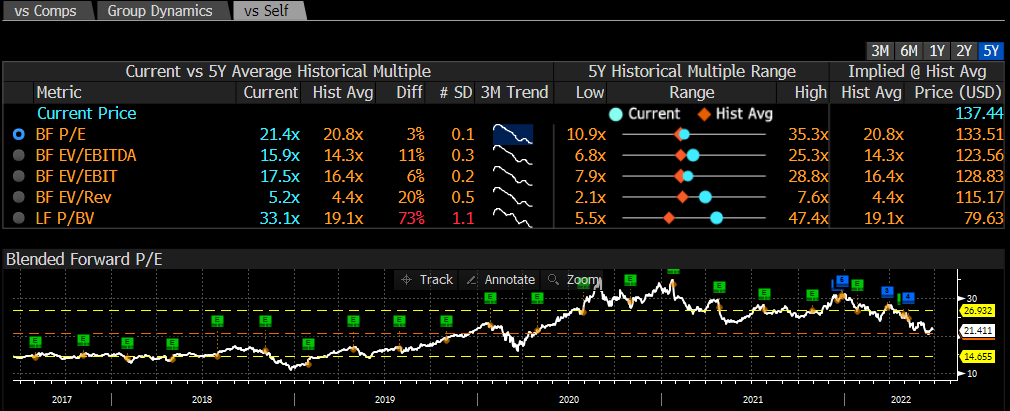fazon1/iStock Editorial via Getty Images
Apple (NASDAQ:AAPL) has not released any new major product for some years now, with the Apple Car and the AR/VR headset the two most anticipated new products to be launched in the near future. However, these products should have a limited weight on the company’s revenue mix and aren’t likely to boost Apple’s growth prospects significantly.
Product Diversification & Innovation
Apple is one of the largest companies in the world and has the most valuable brand globally, according to Interbrand. This clearly shows that it has a unique position in the technology sector, which was built based on its innovation capabilities and distinctive products.
Apple’s current product portfolio is quite diverse among smartphones, tablets, laptops, and wearables plus its services offerings. Despite that, Apple is still heavily reliant on the iPhone, which represents more than half of its annual revenues, while other products have much smaller weights.
Due to its great success in the past, investors’ and consumers’ expectations for new products are usually quite high, and people are always expecting a new blowout product to come to the market soon. This has not exactly happened in recent years, considering that the last major new product was the Apple Watch which was released in 2015, or seven years ago. This means that Apple has struggled over the past few years to truly innovate, failing to bring anything really new to the market.
Indeed, its strategy seems to have changed from developing new products and segments, such as the tablet in 2010, to focus on wearables and services, which have increased the weight on total revenues in a significant way throughout the past few years.
Considering that Apple has not launched a new major product for several years, this has led investors to increasingly question if Apple still has the capacity to innovate or if over the long-term Apple will take the footsteps of other large technology companies that have lost a dominant position in their industry, such as IBM (IBM). If that is the case, a much lower valuation may be warranted over the long term, as the company’s growth prospects will not justify a premium valuation.
Nevertheless, taking into account Apple’s historical innovation capacity, there has been some speculation about new products in recent months, with the Apple Car and the Virtual Reality (VR) headset being the two most widely speculated products to be launched in the near future.
I’ve analyzed the Apple Car in a previous article, and I think it is a questionable move by the company to enter the auto industry and is not likely to represent much of its total revenues because it is expected to be focused on the luxury market. This means that the VR headset is the only new product that can potentially change Apple’s revenue stream in a significant way in the near term, if consumer adoption is good for this product.
Apple’s AR/VR Headset
While virtual reality/augmented reality (VR/AR) headsets are not particularly new, as they have been used especially in gaming for many years, a VR headset from Apple is highly anticipated and could, potentially, be a key factor for the development of the metaverse.
The metaverse is a virtual environment where people can be together in digital spaces, where people will be embodied rather than just looking at it. A critical technology to achieve this is augmented reality and virtual reality (AR/VR), which enables people to hang out, play games, work, and more in an immersive game-like world.
Meta Platforms (META) has been one of the companies which has invested more in this industry lately, as the company is betting big on the metaverse. Meta offers the Oculus Quest 2 VR, which has had some success and has sold some 15 million units since its launch in 2020, according to IDC. This shows that consumer adoption of VR headsets is growing rapidly, being increasingly used for other activities beyond gaming.
However, according to Grand View Research, the total addressable market (TAM) for VR headsets globally was only $21 billion in 2021, showing that this market is still relatively small. Growth prospects are good, taking into account that the expected CAGR is 15% from 2022-2030, which means the TAM is estimated to reach about $69 billion by 2030. As shown in the next graph, there are several applications for VR headsets, even though gaming is still the most used one.
VR applications (Grand View Research)
Despite this somewhat limited market size for VR headsets, a potential milestone for this technology can be reached next year, when Apple is expected to enter the AR/VR market with its own hardware. Given that Apple has a loyal customer base and a successful history in entering new markets, this can be a pivotal moment for vast adoption of VR technology, which can also be key for the success of the metaverse.
According to several leaks, Apple’s highly anticipated VR headset is a high-end device that will combine virtual and augmented reality. Apple’s goal is to compete with the best VRs available in the market and to be a separated product from the Apple Glasses, which are pure augmented reality. It is expected to use the new M2 chip, which means it could be as powerful as a MacBook Pro, and 16GB of RAM. The expectation is that the launch of the Apple VR will boost demand for associated AR games and apps, which are critical for its success over the long term.
Apple’s AR/VR headset is expected to be like a typical VR headset, but with a number of exterior cameras and sensors that add extra functionality. This means it can offer body tracking, and incorporate real-world environments in a virtual space. This would be an edge over the Oculus 2 for instance, which is VR-only.
This new product was expected to enter the market during 2022, but reportedly there has been some push back due to development issues, namely overheating, cameras and software issues. The most recent expectation is for development to be finalized by the end of this year, with the product expected to be on sale by 2023.
Even though an Apple VR headset can be an important product to boost growth in the AR/VR headset market, considering current estimates for TAM on a global basis, this product should not have a large weight on Apple’s total revenues over the coming years. In its last fiscal year, Apple’s revenues amounted to $365 billion and are projected to reach about $450 billion by 2025. Assuming that Apple’s VR headset would be very successful and grab a 50% market share in three years, this would generate some $18 billion in revenues by fiscal year 2025. This means that the AR/VR headset would represent some 4% of Apple’s total revenues, which would be a very small weight on the company’s revenue mix.
AAPL Valuation
While Apple’s growth was very strong over the past couple of years, boosted by the pandemic and higher demand for consumer electronics and also the 5G upgrade phase on the iPhone, the company’s growth prospects in the next few years aren’t particularly impressive. The current macroeconomic environment is challenging for large companies such as Apple that rely on consumer spending, which is expected to slow down due to lower economic activity across the globe.
This means that for Apple to report strong revenue growth it needs new products, but the AR/VR headset and the Apple Car are niche products and should have a limited impact on Apple’s revenue growth. Indeed, considering sell-side estimates, its revenue growth expected in the next four fiscal years (including FY 2022) is only 5.8% per year, which is not particularly impressive.
Despite the lackluster revenue growth in the medium term, Apple’s shares have been quite resilient during this bear market and are down only about 25% from their all-time highs, a much better performance than compared to most technology companies. This means that its valuation has not de-rated much in recent months, and is still trading at a higher level than its historical average, as shown in the next graph.
Valuation (Bloomberg)
Apple is currently trading at 21.4x next twelve months’ earnings while its historical average over the past five years is 20.8x. However, before the pandemic, its maximum valuation multiple was 22x forward earnings, and only during the bubble of 2020-21 did it reach an extreme valuation above 30x earnings. Moreover, prior to 2020, its valuation multiple was usually in the range of 10-15x earnings, a multiple that seems more appropriate for a company that is projected to grow its revenues by mid-single-digit over the next few years.
Thus, despite its recent correction, Apple’s shares can be considered to still be overvalued right now and further downside is likely ahead, as current estimates may be too optimistic if major developed economies enter into a recession in the coming months and demand for its products decline as people will be less willing to buy high-end products.
Conclusion
Apple is a great company and historically innovation has been one of its key strengths, a situation that has changed in recent years as the company has struggled to offer new products that make a real impact on its revenue mix. The Apple Car and the AR/VR headset are the two most highly anticipated new products to enter the market, but most likely they will be niche products that will not be a game-changer for the company’s fundamentals.
While Apple has great fundamentals, its growth prospects are somewhat low and this is not reflected in its current valuation. For long-term investors, this means Apple is a ‘hold’ right now, but if you are an investor that is sensitive to market timing, then it’s probably best to sell Apple’s shares as new products aren’t likely to boost its growth by much in the next few years.






